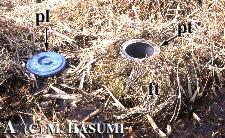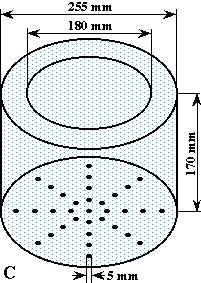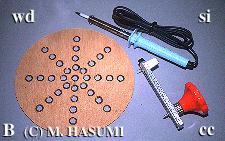


 |  |
 |
(B) Three kinds of tools for handcrafting 160 plastic pitfalls. I made 33 holes of the bottom of the pitfall (see Fig. C), using the soldering iron (si) and the mold of the wooden disk with the 33 holes (wd). I made the interior opening of the pitfall, using the adjustable circle cutter with the radius up to 105 mm (cc).
(C) A diagram depicting a handcrafted, plastic pitfall with a cylindrical shape (255 mm diameter and 170 mm depth), an interior opening (180 mm diameter) for trapping at the top, an overhang (37.5 mm width) toward the inside at the top of surrounding walls, and 33 holes (each 5 mm diameter) at the bottom for drainage.